The national symbols of Scotland are special objects, pictures, or traditions that represent Scotland and its unique culture. These symbols often come from old Scottish stories and customs. While many don't have an official status, they are well-known both in Scotland and around the world. Some, like the Royal Arms of Scotland, are official and recognized symbols.
Flags of Scotland
 |
The national flag of Scotland is called the Saltire or St. Andrew's Cross. It is said to be from the 9th century, making it one of the oldest national flags still used today. The Saltire is also a part of the Union Flag. |
 |
The Royal Banner of Scotland is another important flag. It shows the Royal Arms of Scotland. People often call it the Lion Rampant. You can often see it at sports events where Scottish teams are playing. |
Scottish Heraldry
Main article: Scottish heraldry
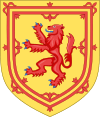 |
The Royal Arms of Scotland is a special coat of arms. It stands for Scotland and its kings and queens. It features a red lion with blue tongue and claws on a yellow background. This is surrounded by a red double border. Even though Scotland joined with England in 1707, the Royal Arms still represents Scotland. You can see it on some coins and on the emblems of Scottish sports teams. |
 |
The thistle is Scotland's national flower. It also appears in Scottish and British heraldry. You can find it on symbols, logos, coats of arms, and British money. |
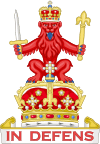 |
The Honours of Scotland are Scotland's own Crown Jewels. They are kept safe in Edinburgh Castle. These jewels are only taken out for very special events. They are also shown on the royal crest. You can see them on badges for groups like the Royal Regiment of Scotland and Police Scotland. |
National Anthems
- Flower of Scotland is widely considered Scotland's national anthem. It is played at many events, like football and rugby matches. It is also used for the Scottish team at the Commonwealth Games.
- Scotland the Brave
- Highland Cathedral
- Scots Wha Hae
- A Man's A Man for A' That
- Freedom Come-All-Ye
Cultural Symbols
 |
Burns' Night is a yearly celebration. It honors Robert Burns, Scotland's national poet. People enjoy traditional food and poetry readings. |
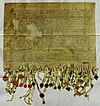 |
The Declaration of Arbroath was written in 1320. It was a letter asking the Pope to recognize Scotland's independence. Tartan Day is a newer celebration from Canada. It celebrates Scottish culture on the anniversary of this Declaration. |
 |
The Stone of Scone is a block of red sandstone. Scottish kings used it for their coronations. It is seen as a symbol of Scottish unity and independence. |
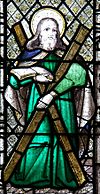 |
St Andrew's Day is on November 30th. It is Scotland's national day. Since 2007, it has been an official bank holiday in Scotland. |
 |
Tartan is a special woven pattern. It often shows which Scottish clan a person belongs to. You can see tartan on traditional kilts. |
Flora and Fauna of Scotland
Scottish Food and Drink
 |
Haggis is one of Scotland's most famous traditional foods. It is often eaten during Burns' Night celebrations. |
|
Irn Bru is a very popular soft drink made in Scotland. It is known for its bright orange color and unique taste. |
 |
Shortbread is a classic Scottish dessert. It is a sweet, buttery biscuit made with flour, sugar, and butter. |
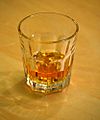 |
Whisky is the most famous drink from Scotland. It is enjoyed all over the world. |
Famous Scottish People
See also
 In Spanish: Símbolos nacionales de Escocia para niños
In Spanish: Símbolos nacionales de Escocia para niños










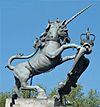
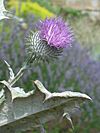

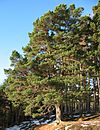



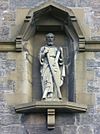

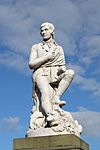

 In Spanish: Símbolos nacionales de Escocia para niños
In Spanish: Símbolos nacionales de Escocia para niños
